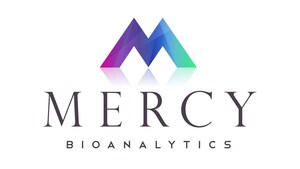
WALTHAM, Mass., Nov. 20, 2025 /PRNewswire/ -- Mercy BioAnalytics, Inc., a pioneer in blood-based detection of early-stage cancer, today announced data from a groundbreaking study leveraging samples from the National Lung Screening Trial (NLST). The study results suggest that the Mercy Halo blood-based lung screening test may significantly enhance early-stage preclinical lung cancer detection, particularly among individuals at elevated risk who are not currently engaged in low-dose CT (LDCT) screening programs.
The NLST demonstrated a 20% reduction in lung cancer mortality through annual LDCT screening, leading to its inclusion in clinical guidelines in 2013. However, despite two decades of outreach, only 18% of the approximately 15 million eligible Americans are up to date with screening, according to the American Lung Association's 2025 State of Lung Cancer report.
Mercy researchers performed a blinded evaluation of samples from the NLST biorepository using the company's proprietary blood test. These included samples from 48 individuals with primarily LDCT screen-detected cancers and matched samples collected from these same individuals during the prior round of annual screening. All samples were evaluated using a pre-specified classifier, with test specificity set to 90%, exceeding that reported for LDCT. The ECOG-ACRIN Cancer Research Group provided the biospecimens used in the study.
Study Highlights:
- The Mercy test detected 31% of lung cancers one year before the in-trial diagnosis, compared to just 8% of cancers that were positive by LDCT/Lung RADS imaging in the year prior to diagnosis. This superiority for earlier detection was observed across all lung cancer histologies.
- The Mercy test identified 40% of cancers that were missed by LDCT when images are interpreted using Lung RADS, the current standard of care interpretation framework.
- The Mercy test detected 34.4% of cancers in the study cohort, comparable to sensitivity observed for LDCT/Lung RADS sensitivity at 39.5%.
- In samples collected across two sequential rounds of annual screening, the Mercy test score showed an average increase of 79% in detected cases, suggesting potential for longitudinal monitoring.
The study underscores the complementary nature of LDCT and Mercy Halo testing in lung cancer detection. The blood test's comparable performance and ability to detect cancers missed by LDCT suggest it could serve as a stand-alone first-line screen for high-risk individuals not participating in LDCT programs. Additionally, signal velocity may offer a new dimension for future classifier development.
"This study marks a significant step toward expanding lung cancer screening accessibility and effectiveness, potentially transforming early detection strategies for millions of Americans," said Dawn Mattoon, Mercy's Chief Executive Officer. "We're excited to continue development of this assay as we look to build on our exceptional ovarian cancer test portfolio with the addition of lung cancer indications."
About Mercy BioAnalytics
Mercy BioAnalytics, Inc. is on a mission to relieve suffering and save lives through the early detection of cancer. Early-stage cancer is difficult to detect, but when found, is more often amenable to curative therapy. The patented Mercy Halo™ liquid biopsy platform utilizes biomarker co-localization to interrogate highly abundant, blood-based extracellular vesicles that carry unique cancer signatures from their parent cells. The Mercy Halo platform is designed to detect early-stage cancer, when it is most treatable, and enhance the quality of life for cancer patients and their families. Mercy's initial focus is the early detection of ovarian and lung cancers. Ovarian cancer, the most lethal gynecological cancer, typically goes undetected until it is too late to cure. Lung cancer, the number one cancer killer, takes more lives than breast and prostate cancers combined.
About the NLST
The National Lung Screening Trial (NLST) was a large randomized controlled trial that compared low-dose helical computed tomography (CT) scans with standard chest X-rays for detecting lung cancer in individuals at elevated risk associated with tobacco use history. A total of 53,454 eligible participants, aged 55-74 years, were recruited between 2002 and 2004 and randomly assigned to receive three annual rounds of screening with either low-dose CT or chest X-ray. The trial found that low-dose CT screening reduced lung cancer mortality by 20% compared to screening by chest X-ray (New England Journal of Medicine, 2011). The NLST was conducted by the American College of Radiology Imaging Network and the National Lung Screening Study Group with funding from the National Cancer Institute of the National Institutes of Health (NIH). In 2015, another NIH-funded study was published (Annals of Internal Medicine) following re-interpretation of the LDCT images from NLST using the American College of Radiology's recently released Lung RADS v1.0 framework. Application of this framework improved LDCT specificity from 73% to 87%, but reduced sensitivity from 94% to 85%.
About ECOG-ACRIN
The ECOG-ACRIN Cancer Research Group is a membership-based scientific organization known for advancing precision medicine and biomarker research through its leadership of major national clinical trials that integrate innovative genomic approaches. Nearly 21,000 member researchers and advocates from approximately 1,400 academic medical centers and community hospitals worldwide collaborate across 40 scientific committees to design studies spanning the cancer care spectrum, from early detection to the management of advanced disease. The group was formed in 2012 through the merger of the former Eastern Cooperative Oncology Group and American College of Radiology Imaging Network. To learn more, visit www.ecog-acrin.org and follow us on X @EAonc, Facebook, LinkedIn, YouTube, and Instagram.
ECOG-ACRIN is supported by the National Cancer Institute of the National Institutes of Health under awards U10CA180820 and U10CA180794. The content of this study is solely the responsibility of the authors and does not necessarily represent the official views of the National Institutes of Health.
SOURCE Mercy BioAnalytics






Share this article